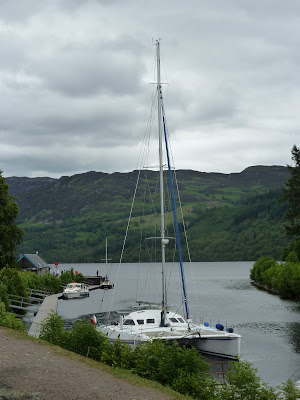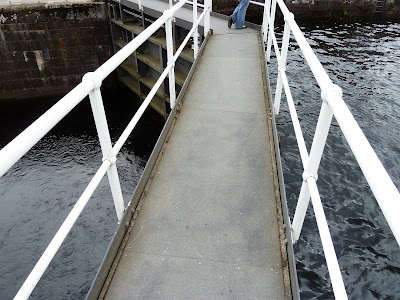
The last time I was in the Highlands, in 2008, it rained when we passed through Glen Coe. This time it showered through the Trossachs, eased off in Glen Coe, and ended before we reached Loch Ness.


Last week we all went to Ireland, but my grandson couldn't miss any more school, so his mother stayed with him at home whilst I joined my son-in-law, and his sister and nephew from California for a two-day visit. Also, to give Steve a break from driving, we joined a small tour group to drive up through the Highlands to Loch Ness and back to Edinburgh in one day. Our first stop was to see 18-year-old "Hamish" who, according to James, our guide, has survived only because he was too old for the food chain when BSE and Hoof & Mouth disease swept through Scotland. According to James, "Hamish" is "an hairy coo" and some Scottish critters are "smooth coos."

Our first photographic stop was in Glen Coe, at the very moment my camera announced that my 8gb memory card was full. I grabbed a few photos on the camera memory, and then began erasing earlier photos like mad. I asked an Asian youth to take this photo, and a few minutes later he and his friends asked me to take theirs.

Approaching Glen Coe, we had passed through the Rannoch Moor.



Perhaps the Highlands wouldn't be so spectacular to see without a good blanket of emotive mist!

James is an excellent story-teller and I enjoyed his narratives about the history of the glen clans. He focused on the Glen Coe Massacre, in which 38 members of the Maclan MacDonalds of Glen Coe were brutally murdered on 13 February 1692, killed by a force of Campbell militia (or government troops). The official reason was that the chief of this MacDonald clan had been a day late taking the Oath of Allegiance to King William (of Orange) so his clan had to be taught a lesson about loyalty. The horror of the massacre was worsened when it became clear that the Campbells had accepted billets with the MacDonalds, in adhering to the Highland custom of offering hospitality to those who asked, even if they were your enemies. Rising from their guest beds early, the troops set about killing their hosts in their own beds, thus breaking the code and murdering "under trust." William ended up with blood on his hands, and his militia mostly failed in their task, when an unplanned gunshot became an alarm that warned the remaining MacDonald kin to flee into the hills.

Glen Coe is known as the "Weeping Glen," in part because of its tragic history, and also because water seems to weep from fissures in the rocks after rains. Fortunately, we had only light showers!




This stop offers views of Buchaille Etive Mor, guarding the eastern approaches to the glen, and the "Three Sisters," the long spurs running off Bidean nam Bian, the highest peak in Argyll. Matching the south-side features is the long wall of the Aonach Eagach ridge enclosing Glen Coe to the north.







The road then follows Loch Leven through Onich and up past Ben Nevis, unseen here today. As James said, Ben Nevis is only visible 20% of the time.

Seeing this clear-cutting reminded me of my own grandfather from Newfoundland, a lumberman. William Archibald "Skipper Arch" Sheppard joined with his cousin, Forward Ball, and other local men from Northern Arm, to enlist with the Newfoundland Forestry Regiment during World War One. They spent the duration in Scotland, cutting trees for the war effort in Europe, for trench building, and likely ammunition boxes, both of which depended on Scottish pine. James told me that most of the trees now seen on these hills and in these valleys were planted after the wars, some as work projects for what the Scots hoped would become a booming lumber industry.

The head of Loch Ness, at Fort Augustus, where we spent two hours.

I found a perch on the edge of Loch Ness, where I posed as bait for Nessie.

My fellow travelers also posed for a photo, unsure about whether to accept James' claim that he believes in Nessie, or that, at the very least, "there is something there," therefore uncertain about whether or not something might approach them from behind.

We were too busy enjoying excellent lunch in an Italian restaurant--go figure--to get to the dock for the Loch Ness cruise, so we found Nessie on shore, alongside this end of the locks of the Caledonian Canal.

A sailboat approaching the locks from the loch, Ness that is. I later chatted briefly with the captain. He and his family had sailed from Helsinki, Finland. Reminds me of my adventurous brother back in Canada, "Scurvy Pete."

A docked catamaran.
Rising along the eastern shores of Loch Ness are the Monadhliath Mountains.

Presumably, a loch boat, larger than most canal boats.

Three motorboats are being lowered through the locks. The operator told me that it takes only 8 minutes to move 1 million gallons into the lower lock.

The lock controls. It is an efficient process and attracts lots of observers. Last time I was here we watched several high-masted sailboats pass down the locks.



The road bridge swings away for only minutes as the boats enter Loch Ness.

Passing through Lochaber.

We retraced our steps along Lochs Oich, Lochy & Linnhe.



Just before Spean Bridge, we pulled over at the Commandos Monument to look over at the mountain range that includes Ben Nevis, but the highest peak in Scotland is still enshrouded in clouds.


Ben Nevis' peak is somewhere behind those still visible.

The Commando Memorial or Monument was designed by Scott Sutherland. It was unveiled by the Queen Mother in 1952, looking over the Leanachan Forest towards Ben Nevis and Aonach Mor. Winston Churchill had created the elite Commandos unit in 1940. On the memorial is a plaque that reads: “In Memory of the Officers and men of the Commandos who died in the Second World War 1939-1945. This country was their Training Ground.” Apparently, this area is still used for military training as we saw a modern fighter jet race close above the water of one of the lochs.








Somewhere in the Grampian Mountains, likely along Loch Laggan, en route to Laggan and thence south.


The water in these streams and this loch has been lowered. I just noticed in passing a dam, so for some reason the loch behind it has been partially drained.


It seems to be filled with what looks like beach sand.

We arrived at Dalwhinnie, where James pointed out the Dalwhinnie Distillery, and gave us a brief account of the magnificence of Single Malt Whiskey.

In the Blair Atholl and Killiecrankie area, where, in 2008, we visited the beautiful Blair Castle, which I wrote about in an earlier blog.

About 6:00 we stopped at the famous Pitlochry, but the shops were closed.

Our 33-passenger tour bus, operated by Heart of Scotland Tours. The only complaints we had were with the four German women, likely about twenty, who brought along a huge Tesco Supermarket bag filled with junk food, mostly foul-smelling crisps that smelled up the entire van, already warm from the heat of the day. And James was not tough enough with laggards, people who strolled back to the bus at their own pace instead of at the announced times. In one case a couple strolled back leisurely sipping on coffee while we had waited twenty minutes on the hot bus. I muttered about their rudeness. The Asian girl in front of me repeated what I had said aloud, to the couple who had kept us waiting!

James Donaldson was an excellent host and guide, telling us all kinds of interesting tales.

Approaching Edinburgh, alongside what I believe are the Ochil Hills.

The famous red railway bridge spanning the Firth of Forth. It is estimated that the surface area of the bridge requiring paint is 146 acres. It take 8,403 gallons of red iron brushing paint to cover the steel, an on-going process that has given rise to the saying that one is "painting the Forth Bridge" describing a never-ending task. James explained that a multi-year project involves encasing all the steel in some sort of plastic, costing millions of pounds. James told us of the 60,346 ton of steel and the seven million rivets. Fifty-seven people died in its construction.

He also told us a questionable story about a worker whose body is still entombed in one of the steel columns, having slipped in during construction. He survived the "fall" or "slide" but there was no way to get him out. James said they lowered some food and a bottle of whiskey to the unfortunate wretch, and then went on with construction!

Tucked under the Queensferry end of the bridge is Howes Pub, a wonderful pub in which we ate in 2008, staying at a B&B in nearby Dalmeny. Today required many hours of driving, but the tour served its purpose--to introduce Scotland's scenery to Steve's family--and tomorrow we will spend the day in Edinburgh.

No comments:
Post a Comment